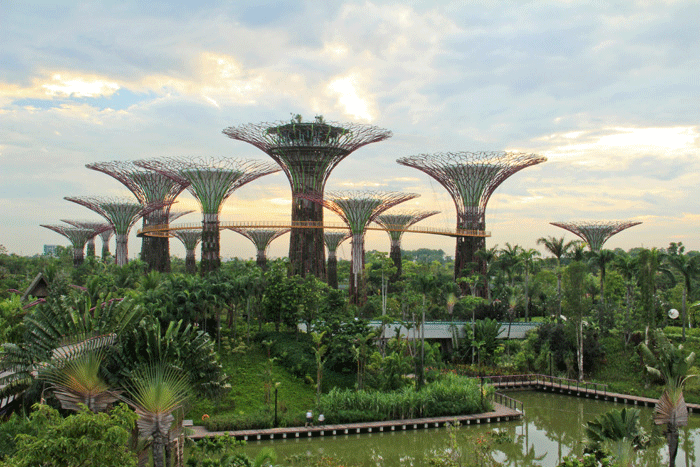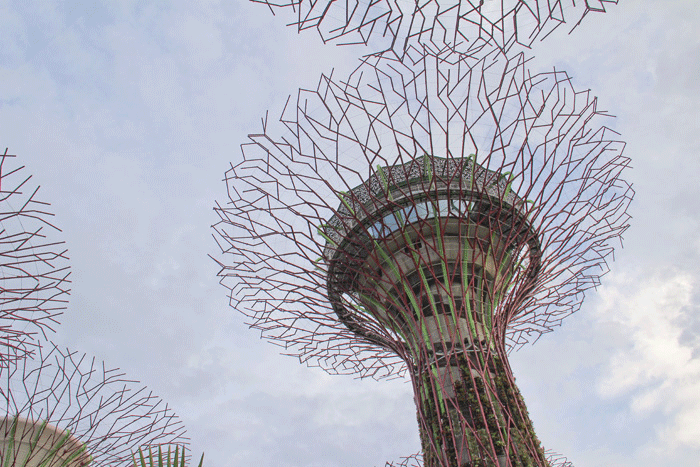At Gardens by the Bay in Singapore, Tekla Structures helped bring to life a forest of ‘Supertrees’ crafted from steel and concrete
Gardens by the Bay is a nature park spanning 101 hectares (250 acres) of reclaimed land in central Singapore, adjacent to the Marina Reservoir.
The park consists of three waterfront gardens: Bay South Garden, Bay East Garden and Bay Central Garden. The park houses conservatories that showcase plants native to more temperate climates as well as themed gardens that explore the different cultural traditions of Singapore. One of the park’s highlights, however, is mineral rather than vegetable in nature: 18 giant steel and concrete trees, each between 25m and 50m high.
These ‘Supertrees’ consist of concrete trunks, topped by a canopy made of complex steel tubes that form the branches. Some of them also integrate solar cells that generate power for use in the conservatories below.
The trunks of the Supertrees are similarly clad in a steel frame and draped with many types of climbers, flowers and ferns. To add to the complexity, a 128m long suspension bridge, the OCBC Skyway, links two of the taller trees together and allows visitors to soak in the view from 22m above ground level.

Critical component
Steel was a critical component for the entire project, from the frames around each trunk to the network of branches that form the canopy. As the complex design geometries were vast, Singapore-based TTJ Design and Engineering turned to Tekla BIM software for the entire project. Having used Tekla Structures for over ten years, the software is key to TTJ’s operations and the firm relies on it for intricate designs and highly complex jobs like this one.
TTJ worked closely with the architects and structural construction consultants to fabricate the parts needed for the Supertrees. Working with the design drawings for construction, TTJ began by using Tekla Structures to create the general arrangement drawings, together with connection details, before sending the drawings to all relevant parties for approval.
“Any time you have curved parts, it is good to use Tekla,” says Madam Tan Yumin, engineering manager at TTJ. This is because the other software products used by TTJ have difficulty in handling curved shapes.
Tekla BIM software was especially useful on this project because of the complex geometries involved in constructing the canopy. The interlocking branches at the crown of each tree reveal a delicate network of steel tubes encircled by a stainless steel cable that pulls the structure together. The cable ensures that the branches do not start sagging and put undue stress on the entire canopy. To reduce the weight of the overall structure, the steel used in this canopy is very thin, just 3.2mm thick in parts. As a result, only 920 tons of steel was used to build the soaring Supertrees.

Steel fabrication benefits
According to Madam Tan, Tekla has numerous attributes that make it ideal for steel fabricators; in particular, it speeds up the fabrication process. It is able to handle changes on the fly, for example, so that any amends proposed by the architect to the original drawing are automatically reflected in the general arrangement drawing. TTJ took about six weeks to model each tree with Tekla. “If we had used ordinary CAD software to create the models, it would have taken us three times longer,” Madam Tan claims.
Part of what speeds up the process is the extensive library of parts that exist in Tekla and that also supports manual additions. Once the architects and the consultants approved the general arrangement drawings for the tree, TTJ used Tekla Structures to generate the shop drawing for fabricating the joints and every steel part required, right down to the bolts.
At the factory, the drawings were used to fabricate the necessary parts. Apart from shop drawings, this factory also relies on Tekla’s 3D models to help fabricators visualise the structure – a vital step, given its complex geometries. After the parts were made, they were pre-assembled at the workshop for checking, and disassembled before being blasted, painted and then sent to site for erection.
At the site, workers from TTJ began assembling the different parts to reassemble each tree, relying on the drawings and the 3D models to help them. Overall, the project took about two years to go from ideas on a drawing board to the actual structures being in situ, ready to welcome many thousands of visitors.

If you enjoyed this article, subscribe to AEC Magazine for FREE






